#illuminated manuscript border
Text
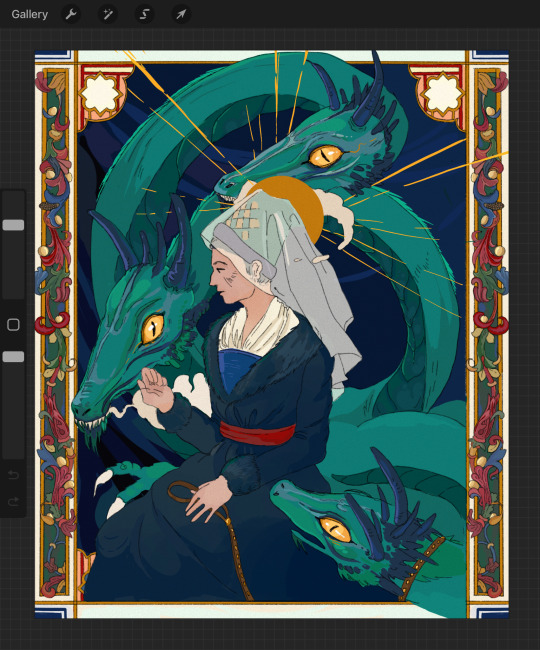
A 15th century gurlll 🐉🤌
#literally why am I suddenly obsessed with illuminated manuscripts#like where did this come from#anyway#this is as sexy of a lady as you’re getting from me#character art#digital art#procreate#1400s#15th century#15th century fashion#illuminated manuscript#classicalfashion#illustration#trans artist#dragon art#pet dragon#illuminated manuscript border#dress history#historical fashion#artists on tumblr#historical fanart#dress historian
173 notes
·
View notes
Text

floral borders growing from a garden
page from a manuscript of the "schwabenspiegel", freiburg, c. 1410
source: Freiburg, Staatsarchiv, Gesetzgebung und Verschiedenes 42, fol. 109r
140 notes
·
View notes
Text
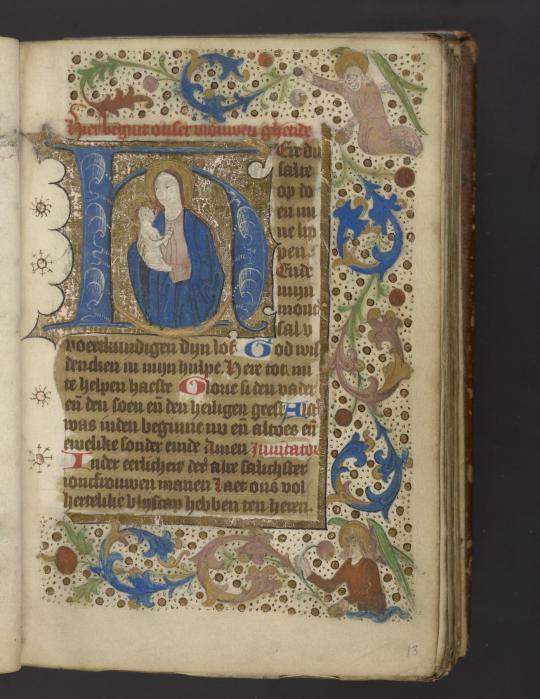




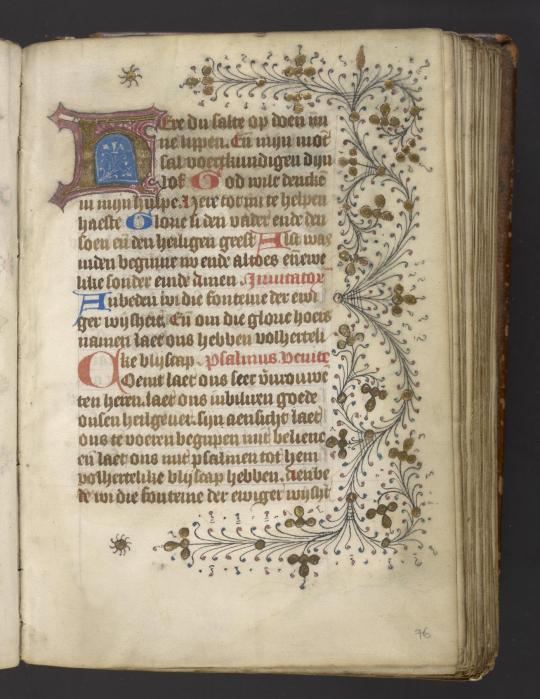
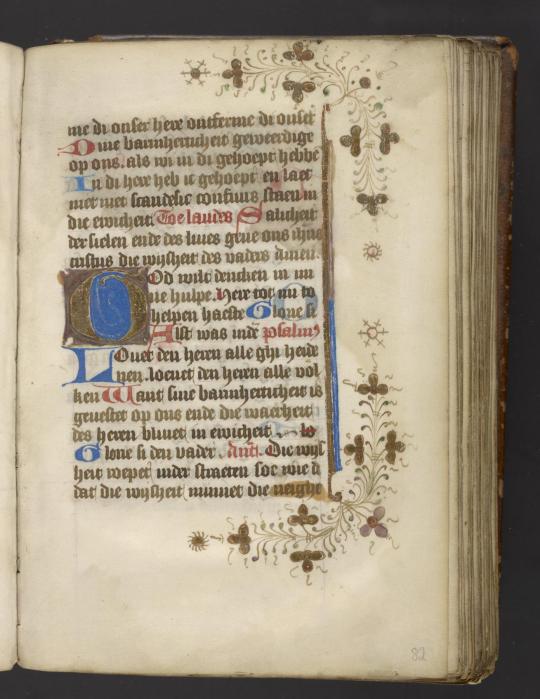
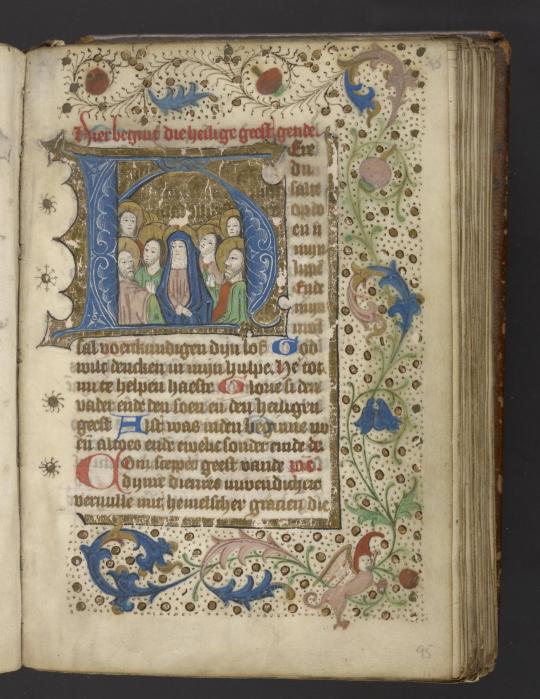
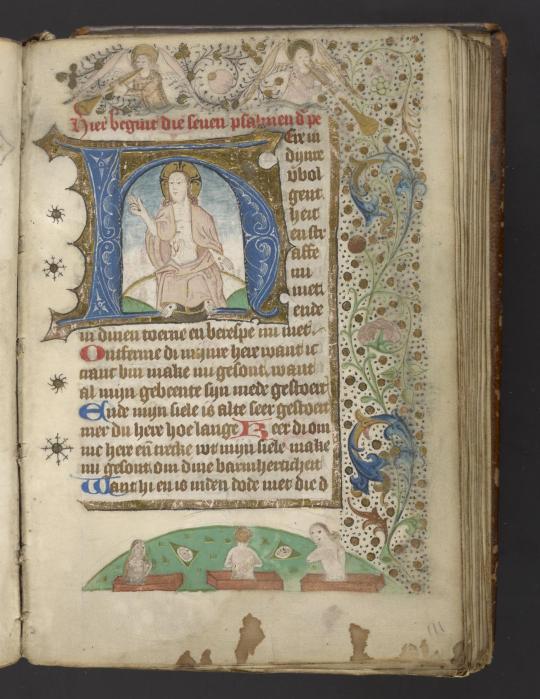
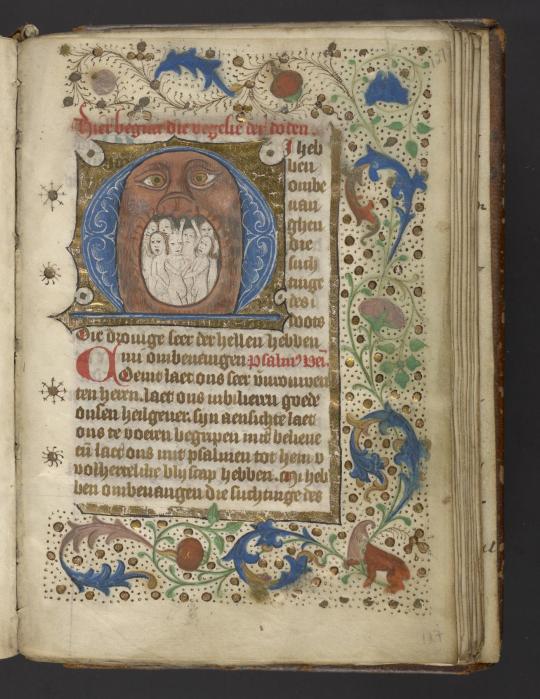
Today's #YearOfHours is Ms. Codex 728, a Flemish hours of the Virgin Mary, with calendar of Utrecht, in the Dutch translation of Geert Groote. Written in the 15th c., It includes several illuminated historiated initials with illuminated borders.
Online:
#medieval#manuscript#book of hours#year of hours#illustration#illumination#15th century#flemish#dutch#historiated initial#illuminated border#book history#rare books
168 notes
·
View notes
Text

wip sketch + colors :^)
#my art#doing the illuminated manuscript border was fun :)#this started completely different than what it ended up being LMAO#i thought maybe to draw him as a knight but i think i like the contrast of having him dressed in modern clothes#artist commentary jk. this is based on the the period of time where jason kept etrigan’s heart in a box <3
22 notes
·
View notes
Photo

Illuminated Border with Flora and Grotesques from a Manuscript (France, 1401–1530).
Manuscript cutting in tempera and gold leaf, on vellum.
Image and text information courtesy Art Institute Chicago.
78 notes
·
View notes
Text
Corvs been playing this video game that's like a murder mystery point and click game set in medieval europe in the style of illustrations from the time (weird looking animals and all) with dialogue boxes that write themselves in different styles of calligraphy and it could not be more laser targeted at them, and they thought that someone recced it on a social media feed, but on further review, they think they saw an ad for it on twitter or smth, which imo is shockingly effective advertisement. (The game is called pentament btw)
#for further context they've been doimg self-directed calligraphy studies for... over a year now i think#and just recently specifically started learning how to do illuminated manuscript borders from an online class#and also are perfectly fine with a game that's immersed in historical christianity which i know is not for everyone#also from what they've casually mentioned it seems like it has good accessibility#like you can switch to an easier to read font if you want and also basically any proper noun in dialogue is clickable for citation
0 notes
Text

FLEUR DE LYS-SHAPED BOOK OF HOURS, in Latin, use of Rome (Paris, c. 1553). Illuminated manuscript on paper.
180 x 80mm. i + 117 leaves, each page with 24 lines written in a 'roman' hand in black ink within a liquid gold border in the shape of a half fleur de lys, spaces infilled with liquid gold fronds on blue or red grounds, line-fillers and one- and two-line initials of the same colours, eleven lobe-shaped miniatures. Nineteenth-century brown morocco gilt, semé with fleur de lys, doublures of red morocco gilt, edges gauffered and gilt (upper cover detached). [Christies Auction House, 2006 catalog]
source
#beautiful books#book blog#books books books#book cover#books#shaped book#fleur de lis#book of hours#latin language#treasure book#book design#book binding#old books
571 notes
·
View notes
Text
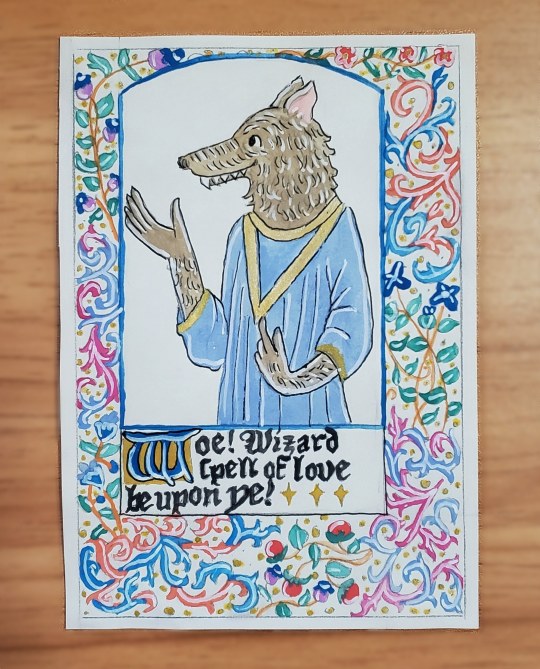
a tiny medieval werewolf comes bringing wizard spells of love 🐺🧙🏻♂️🔮🪄✨💖🌟💞❤️
[ID: A tiny watercolor painting in medieval illuminated manuscript style. There's a border of colorful vines, flowers, and leaves around the outside. In an arched frame there's a painting of a smiling brown werewolf in a blue and gold robe. Below the werewolf is a text box with gothic script reading "Woe! Wizard spell of love be upon ye!" with three gold stars next to the text and the initial W in bright blue over a gold background.]
#this thing is like 3x4 inches#I had to use my tiniest little brush#also here you can see why I do mostly digital art (incredibly shaky hands)#my art#medievalposting
114 notes
·
View notes
Text
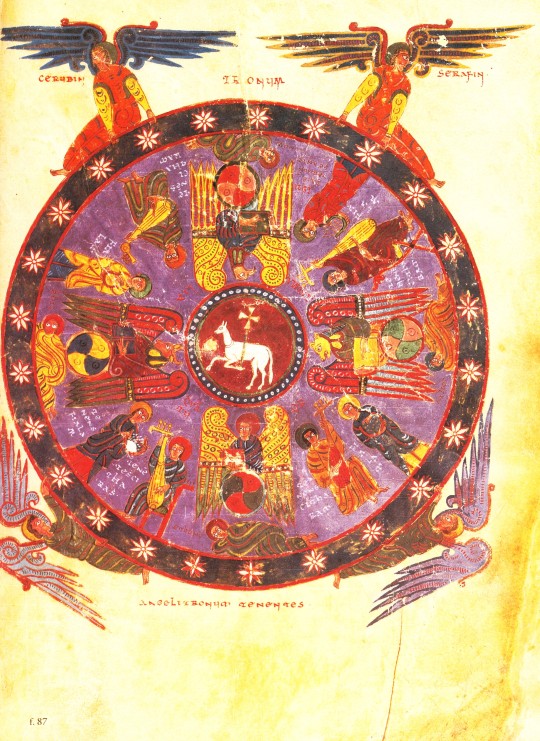

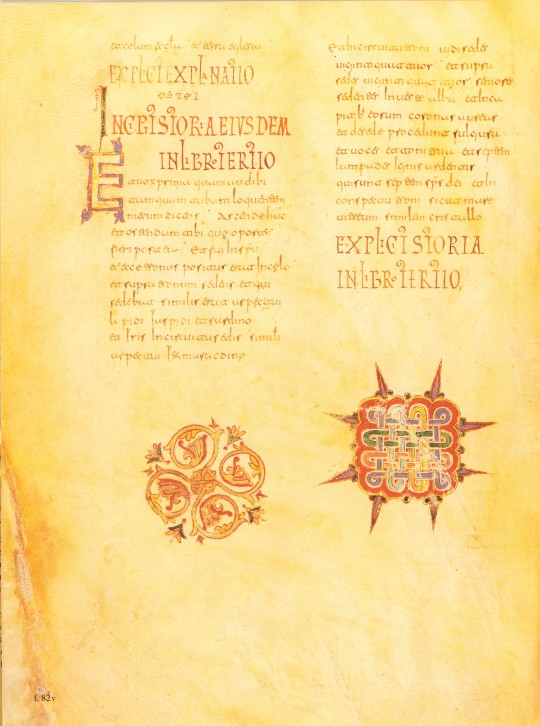
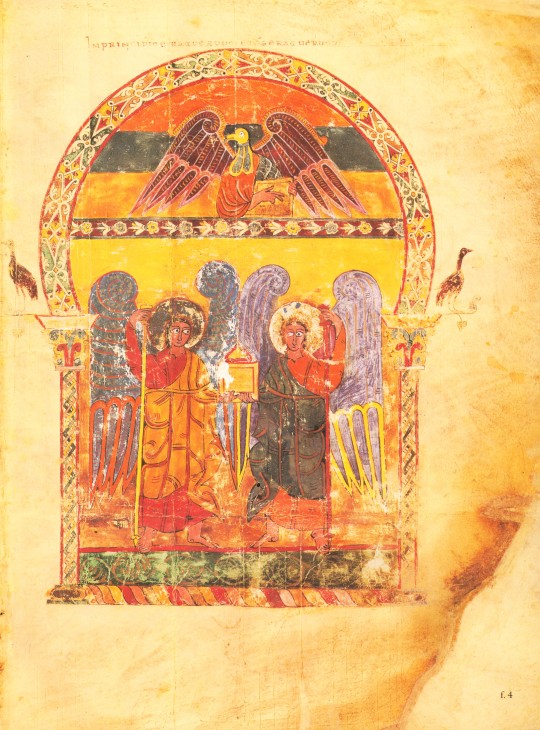




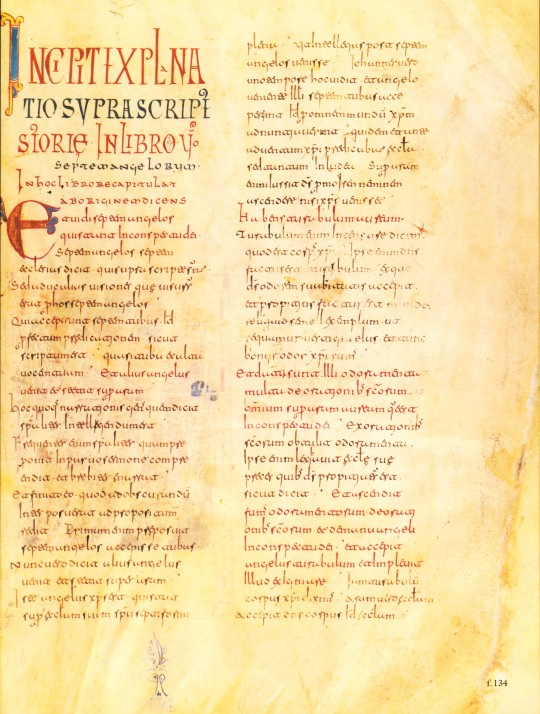
Welcome to Manuscript Monday!
In this series we will periodically focus on selections from our manuscript facsimile collection. Today we present selections from the Morgan Beatus Manuscript, reproduced as A Spanish Apocalypse, The Morgan Beatus Manuscript in New York by George Braziller, Inc. in association with the Pierpont Morgan Library in 1991. The original manuscript, made around 10th century CE at the scriptorium of San Miguel de Escalada in Spain by a monk named Maius, is the earliest surviving illuminated version of the monk Beatus of Liébana's commentary on the biblical Book of Apocalypse (also known as the Book of Revelation). The text of the Book of Revelation makes up the first part of the manuscript, and Beatus’s commentary comprises the second part. The Book of Revelation tells of the end-times in Christianity, during the final judgement of humanity by God. The story within this Biblical book was also seen by those living during the Latin medieval era as representative of the beginning of something new: God’s celestial kingdom. Due to this view of the book, many artists incorporated imagery from this part of the Bible in their work.
Produced in Al-Andalus, or Muslim-ruled Spain, the artistic style of this work combines both Muslim and Christian visual traditions to create a beautifully illuminated manuscript that supplements the commentary by the monk. This artistic style is known as the Mozarabic, which comes from the Arabic mustaʿrib, meaning ‘Arabicized’. Interestingly, this style of art can only be seen in Christian religious art and architecture from Spain at the time, as non-religious artistic objects made by Christians look so similar to Islamic versions of the same works that they cannot be identified as intentionally Christian. Some key Islamic artistic elements within the manuscript include buildings with horseshoe arches, intricate geometric and vegetal patterns as borders for larger images, and the large, bulging eyes of the illustrated animals.
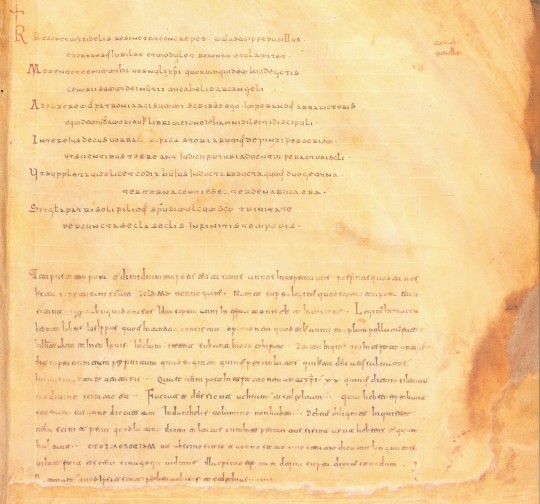
Another interesting aspect of this specific manuscript is the colophon at the end of the manuscript. It tells readers about the circumstances surrounding the creation of this book, including the maker, the patron, the year it was made, and an explanation about why Maius created the manuscript ("I write this . . . at the command of Abbot Victor, out of love for the book of the vision of John the beloved disciple. As part of its adornment I have painted a series of pictures . . . so that the wise may fear the coming of the future judgement of the world's end."). Colophons in medieval manuscripts are not usually as detailed, so the inclusion of all this information contributes greatly to the knowledge and history surrounding the Morgan Beatus Manuscript.
View more Manuscript Monday posts.
– Sarah S., Special Collections Graduate Intern
#manuscript monday#manuscripts#morgan library#morgan beatus manuscript#Beatus of Liébana#Spain#Christian art#Mozarabic#Islamic art style#facsimilies#Spanish art#Medieval art#Spanish medieval art#A Spanish Apocalypse#George Braziller#illuminated manuscripts#Sarah S.
132 notes
·
View notes
Text

The Hunt or Anxiety Dog ft. Sword
Felt like doing an illustration of a long dog with illuminated manuscript and medieval border vibes.
#illustration#art#artists on tumblr#fantasy#original#procreate#digital art#chocotat#dog#illuminated manuscript#medeival#patterns#illustration art#illustrator
36 notes
·
View notes
Text
Buckingham Palace is pleased to share the invitation for the Coronation, which will be issued in due course to over 2,000 guests who will form the congregation in Westminster Abbey. It is also announced today that eight Pages of Honour have been chosen to attend Their Majesties during the Coronation Service.

The invitation for the Coronation has been designed by Andrew Jamieson, a heraldic artist and manuscript illuminator whose work is inspired by the chivalric themes of Arthurian legend. Mr Jamieson is a Brother of the Art Workers’ Guild, of which The King is an Honorary Member.
The original artwork for the invitation was hand-painted in watercolour and gouache, and the design will be reproduced and printed on recycled card, with gold foil detailing. Central to the design is the motif of the Green Man, an ancient figure from British folklore, symbolic of spring and rebirth, to celebrate the new reign. The shape of the Green Man, crowned in natural foliage, is formed of leaves of oak, ivy and hawthorn, and the emblematic flowers of the United Kingdom.

The British wildflower meadow bordering the invitation features lily of the valley, cornflowers, wild strawberries, dog roses, bluebells, and a sprig of rosemary for remembrance, together with wildlife including a bee, a butterfly, a ladybird, a wren and a robin. Flowers appear in groupings of three, signifying The King becoming the third monarch of his name.

A lion, a unicorn and a boar – taken from the coats of arms of the Monarch and Her Majesty’s father, Major Bruce Shand – can be seen amongst the flowers. Her Majesty’s arms are now enclosed by the Garter, following her installation as a Royal Lady of the Order of the Garter last summer.

150 notes
·
View notes
Text


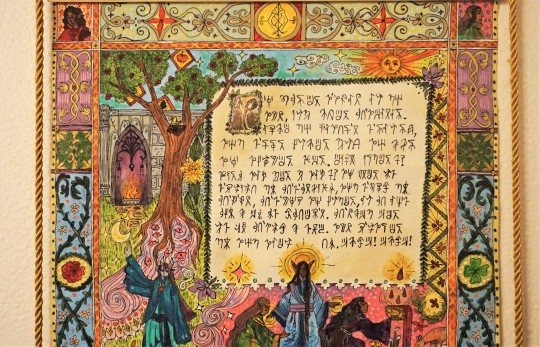
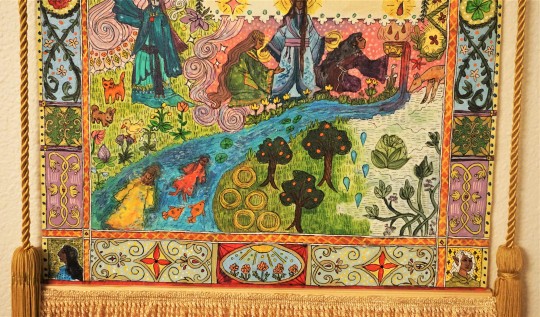

Finally finished my weird hanging painting thing (originally a secondhand partially-done 'paint by numbers' kit that I found at a thrift store and kept to repurpose lol)! Imagery somewhat based in my own worldbuilding projects, and text written in my constructed language for one of my fantasy species, but also vaguely inspired by old tapestries and illuminated manuscripts and etc. I've never been great at neat clean patterning or text, but it looks cool from afar, and I always enjoy making "props" or things that are somewhat like real objects that might could exist in my world. :0
(additional pictures/info under the readmore)
-
Here's what it was originally! I probably didn't have to actually have a river running down the middle because it further makes the composition of the whole thing weird (various connected yet separate locations and things happening, instead of one unified event being portrayed), but I wasn't sure if I'd be able to fully cover up the already existing paint that was there.. and I can also kind of justify it by going with a more "all the imagery is just symbolic so it doesn't have to make exact sense" approach lol.. How is one half of the grass green and the other is suddenly snowy? shhhh.. it's not literal.. shhh...
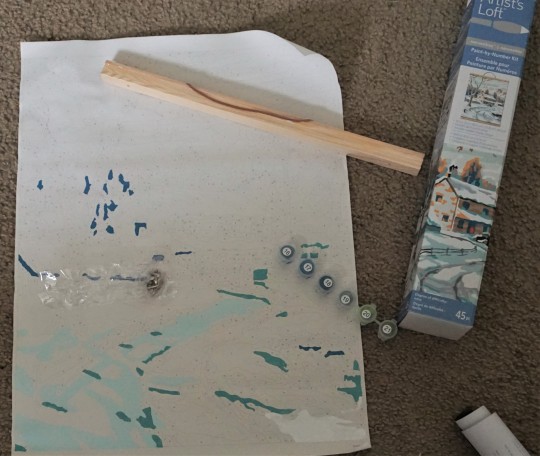
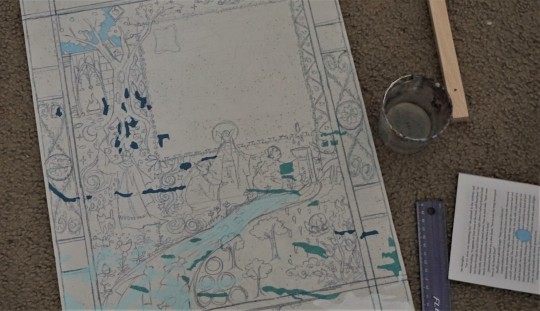
Made a vague sketch, then painted over it, and then added more distinct lines in black pen. Center image first and border second.
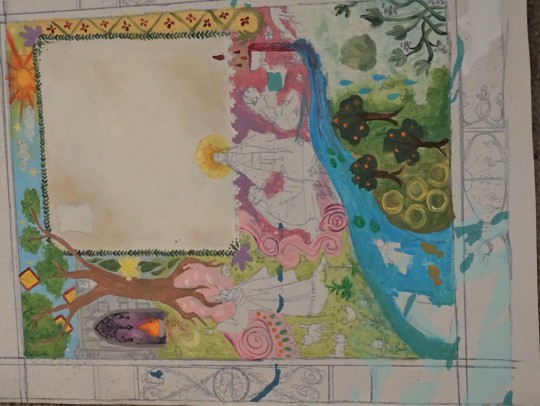
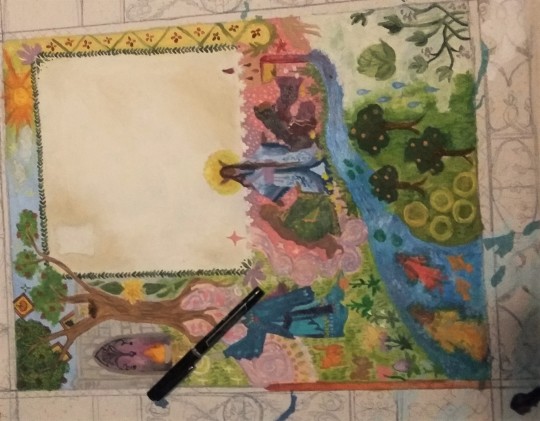
The very last thing was the text, which actually took forever to translate because my conlang is still only like.. partially done, and some of the grammar is not worked out exactly how I would like it to be, so a few sentences I had to think about for a long time before just going "eh, this is probably not how I would do it if I considered it more, but I'll go with it for now" lol . I also am not entirely satisfied with all of the characters for the writing system, but again, it's good enough for a quick project, it doesn't have to be 100% accurate and perfect because it's a fake language that nobody knows anyway lol.
I thought about breaking down the text and translation here like I have for some of the tidbits of Avirrekava (the language) in things I've posted in the past, but I think it would take too long and is not interesting to anyone but me ghghj, so for the sake of getting the post out quickly, I shall not spend an hour typing All That lol.
The general jist of the writing though is that it's just about the Avirre'thel being cast out from the other elves, after abandoning their magic for immortality as a means to truly attain perfection (an important concept in elven culture), the usual, blah blah blah, but how it's Actually A Good Thing, because the gods are wrong and immortality is Cool actually and they like the shitty frozen lands they were sent to, so it's fine that everyone else is being a Hater about it lol

Lastly, here's a few photos outside in the sun to TRY and show the gold detailing actually shimmering or showing up! It really doesn't come through in photos, but there's plenty of little golden spots to highlight light or Importance.
Mostly the fire, the pink sparkle that represents magic, the red drop that represents blood, the light behind Inaashi's hands and head (common symbol for the elven religion/one of their main gods, shout out to anyone who read the ancient elven religion post and recognized that lol), the sun, and the symbol for the Avirre'thel/country of Navyete at the very top. I did a few other gold bits, but they're not highlighted because they're Significant, more just that it looked more symmetrical to have some gold on the border too lol.
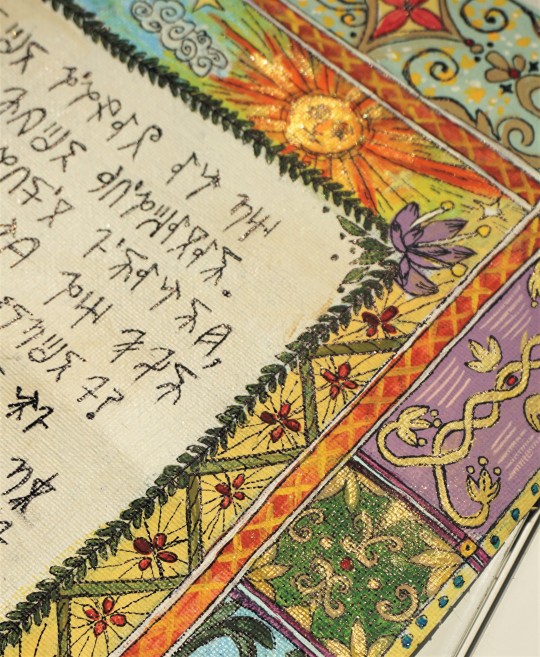
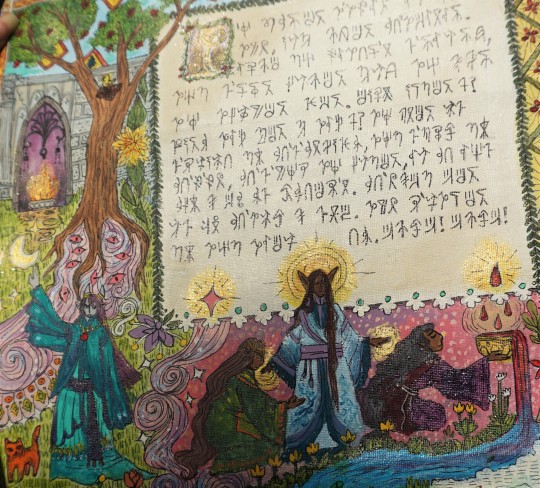
Other things of note: The animals are not actually significant to Avirre'thel culture really, I just wanted to put a cat and a bird because I like them lol. (I also wanted to have a few funny looking creatures, as I was slightly trying to go with the 'in some old medieval painting the anatomy and perspective is very weird' vibe, though I think some of the other parts of it look too Normal to pull it off entirely). Same with the four leaf clover, which means nothing in their culture - but these are the only areas where stuff was just added self-indulgently .
Bligabata (giant cabbage that grows along rivers in Navyete) making an appearance! The architecture of the building IS based on actual concepts for ancient elven/older Avirre'thel architecture and metalwork. The Avirre'thel who's turning away from Inaashi/elves/magic and collecting blood, is doing so in a Special Bowl, as is part of their culture (collecting it in the hands, or just in a normal vessel would be disrespectful, they have Specific Bowls which is the only thing blood can be kept in, etc.).
The figure that represents Jhevona (and thus, a closer connection to magic, celestial imagery, etc.) is in weird ugly teal, which is not necessarily a color or design associated with them, as I don't have much common culture (like clothing) worked out for Northern Jhevona (who the avirre'thel would have come into contact with) yet, BUT everyone else is in more Typical colors (a northern elf in green, Inaashi in lavender + white + blue, an Avirre'thel in darker purples and reds).
Some things, like the four figures in the corners, and the two people + fish in the stream, do not currently have a meaning, but in-world they would.. Like, I could make up lore for how they're culturally significant and it would be true because I am god of the world, but I don't have anything currently. But just know.. they DO mean something, I just haven't decided it yet, maybe kind of fill in as I go, come up with a meaning later lol. Probably along the lines of an old myth from the ancient elven religion, a story, etc.
-
I don't know, probably other stuff, but that's my Trying To Keep It Short rambling for now lol. I'm just glad I finally finished this! For how vaguely sloppy it is up close (everything being completely freehanded, only used rulers once when doing the initial sketch and lining where the border should be + my hands are shaky + the canvas is bumpy + my handwriting is scratchy and terrible + etc. etc.) it still took a REALLY long time, even when not trying to make it all perfect. Especially if including the text translation + writing, which took like 3+ hours itself.
Maybe all the asymmetry/lack of things being centered is NOT because I was too lazy to measure anything, but is actually because in-universe, it's a practice illustration made by some young apprentice who has to work on little canvases for years before he can be trusted will a full sized mural or tapestry. It's his first week on the job! of course he's uncoordinated! don't laugh at him!!! lol
#worldbuilding#elves#I AM WORKING ON A NEW PAVENTURE POST also !!!! I know I keep being like 'oh I'm going to get back to that! I'll stick to it this time!!'#and then another whole month goes by without me posting a new poll adventure - however - this time I DID fully intend to so#*do another one soon but my beloved beautiful perfect cat unfortunately passed away AND there was a heat#wave ANd I felt sick for a while for unrelated reasons so I just genuinely was not focused on posting online at all#I am trying to get back to it though along with other things hopefully so.#ANYWAY#avirre'thel#irithoas#maybe???? not super relevant to elves but I'll keep it intheir tag anyway also. Just since their lore is so closely tied with avirre'thel s#stuff and they're mentioned in the post. Or the gods are. Inaashi is.#OIGUGUGUGUHH I should have done a tapestry with the FCJhjkING triplets!!!!! Sehalanora Semoniyare and the other one whatever the hell#his name is. ... sehalanora my beloved .. (I'm referencing the ancient elven gods - for those who dont know)#It's funny that I rarely watch tv shows and when I do I rarely if EVER care about characters at all in any capacity#with maybe like a handful of even then extremely minor exceptions so I cannot relate to the concept of like 'having a blorbo' or whatever#but then for my extremely niche worldbuilding content#.. it's like OMG MY FAVORITE character!!! my favorite obscure god from a religion#that I entirely made up myself for a cultural group that I also made up that literally only I and maybe like two other#people who are able to sit through my novel long dry and wordy worldbuilding posts care about!! you all know them DUH!!#even WITHIN modern elven culture in the world at the moment in current day most people do not give a shit about them hghj#BUT .. I should have made a painting of the siblings actually!!! I stand by that!!#I mean I like Inaashi and Nisateyu and everything too. Actually all of them are fine except for Ea'ivuyera I guess. whoever the#like War and Order bootlicker god is basically. and the Evil dumbass one. but all the others are fine. I'm suprised I'm even able to rememb#that many ancient elven goofily long names ghgh.. But I could have maybe made it about the elven gods#The thing is just that.. i Don't have ancient elvish worked out as a language and I knew I wanted to put text on it#so it kind of HAD to be something written/drawn by the Avirre'thel#Knwoledge of the ancient elven gods is still a thing in their culture. But usually more as a joke or just a common fairytale knowledge#sort of thing. not really something to make a painting of. Inaashi is here less because of Inaashi The God being genuinely significant and#and more just she's there to Symbolize the elven religion as a whole. just like all the other figures are mere symbols of things. etc.
93 notes
·
View notes
Photo
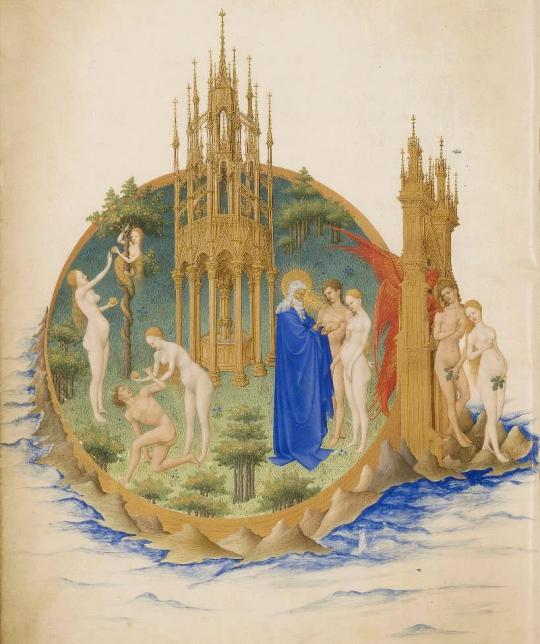
MWW Artwork of the Day (1/25/23)
Limbourg Brothers (Dutch, fl. 1385–1416)
Les Très Riches Heures du Duc de Berry: Fall and the Expulsion from Paradise (c. 1416)
Tempera on vellum, 29.4 x 21 cm.
Musée Condé, Chantilly
The picture has no frame, the border of the whole representation being provided by the wall of Paradise. It is from this frame that Adam and Eve have to enter a world which has no boundaries, in which the very shores of the sea vanish, apparently turning into clouds in the infinity of space. Although the ground of the Garden of Eden is stretched behind the figures like a tapestry, it is not merely a decorative surface, since the gradual darkening of the fresh green lawn conveys spatiality. In fact the hardly discernible nuances of green seem to lend the circle a spherical quality. The painter's intention in this respect is also evinced by the use of perspective in the delineation of the fountain and also of the gate (for example, the roof of the fountain is seen and represented from below, whereas its hexagonal basin appears as if seen from above; indeed, the latter does not turn as steeply into the plane of the picture as does the ground itself).
For more Medieval illuminated manuscripts, see this MWW Special Collection:
https://www.facebook.com/media/set/?vanity=TheMuseumWithoutWalls&set=a.419770264795015
145 notes
·
View notes
Text

Biblia Latina, fragment.
Ms. France or southern Flanders, early fourteenth century.
Written in dark brown ink in a regular Gothic hand; text in 2 columns of 50 lines.
Decoration: 11-line initial P historiated with standing figures of the Virgin and six men (one with nimbus) in colors against burnished gold background, with full-length bar border sprouting into sprays of ivy leaves (including a small dragon figure), in gold and colors; 6-line illuminated initial, with full-length bar border with sprays of ivy leaves extending along left margin, in gold and colors; 3-line illuminated initial with full-length bar border of ivy leaves extending along right margin of verso, in gold and colors; headlings in red, chapter numbers and running titles in alternating red and blue letters.
This leaf is from a lectern Bible once owned by lawyer and judge Mirmellus Arnandi and left to a Dominican convent in 1450. The manuscript was sold at Parke-Bernet, New York, 30th November 1948, lot 326 to Otto F. Ege (1888-1951) who dispersed the leaves.
c.1300
Rare Book Collection, Detroit Public Library
#biblia latina#manuscript#latin#bible#ms#14th century#illuminated manuscript#medieval#middle ages#books#ege#arnandi#gothic#ms.#mss#detroit public library
28 notes
·
View notes
Text
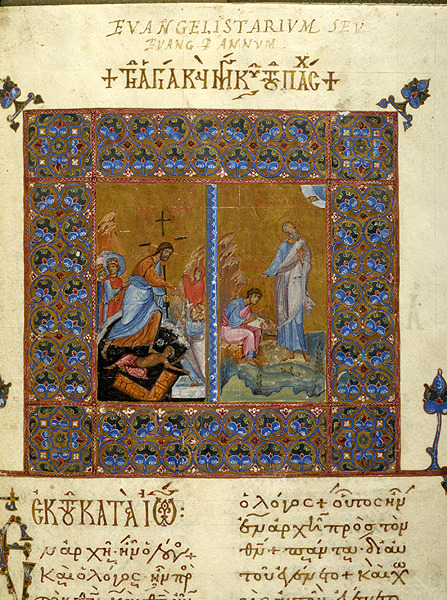
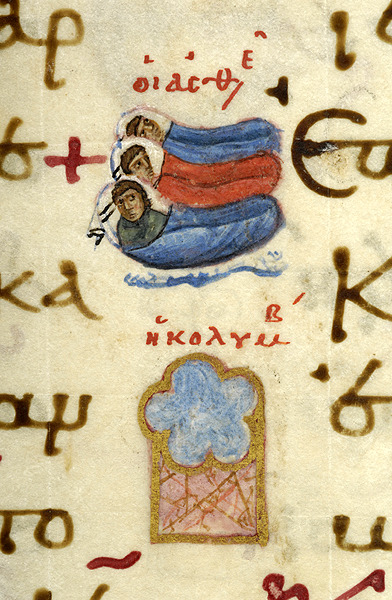



Some details of marginalia and illuminations in MS. M. 639, an 11th-century Byzantine Greek gospel from Constantinople. (Now held in the Morgan Library in New York.) Check out the incredibly intricate and colorful borders on the biblical scenes, the three vaguely disgruntled dudes in sleeping bags, the annotations and rubrics in red ink, and the bilingual Latin-Greek header on the first page. Also, if you are bored and need something to do, want to stare at pretty pictures, are looking for research material, or just desire to kick some idiot claiming that the medieval world "had no art" directly in the nards, I strongly advise exploring all the digital images of the various medieval and renaissance manuscripts in the Morgan's collection.
96 notes
·
View notes
Text

Golden oldie
A little golden elephant hangs out in the corner of the table of contents for the gospel of St Mark in the Lothair Gospels, made between 849 and 851 for Lothair I, Charlemagne's grandson. This manuscript is extraordinary in many ways-- there's lots of expensive purple and gold, a portrait of Lothair himself, the works-- but one of the most interesting features is this tiny elephant, because it is recognizably an elephant. (It can be contrasted with some other attempts at drawing "elephants" from Northern Europe on this blog.) So why did these artists get it right?
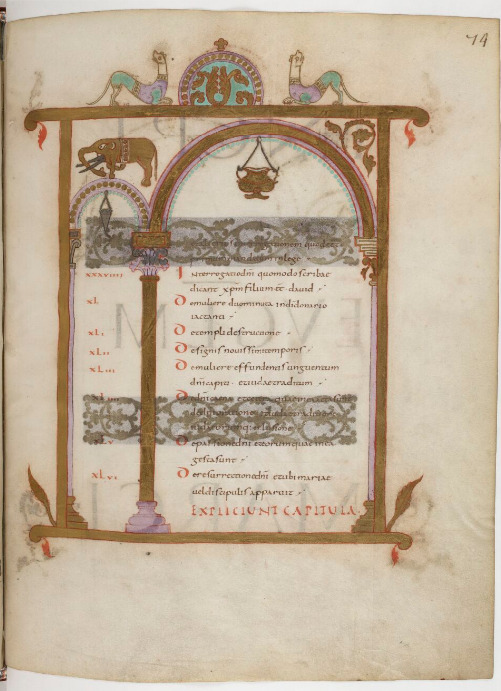
Well, people were still alive in the Frankish realms who had actually seen an elephant! In the early 800s, the Abbaids caliph Harun al-Rashid sent Lothair's grandfather, Charlemagne, an elephant called Abul Abbas. Charlemagne had allied with the Abbasids (based in Baghdad) against the Umayyads (based in the Iberian peninsula), who were the rival power along Charlemagne's southern border and who were the descendants of the dynasty the Abbasids had overthrown in order to claim power. You can read more about this in Sam Ottewill-Soulsby's new book, The Emperor and the Elephant.
Side note: these Carolingian illuminators were into pink and blue 1000 years before Taylor Swift entered her Lover era.
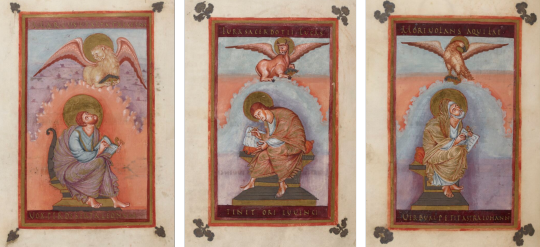
Materials: Parchment, pigments, gold, ink
Origin: Abbey of St Martin, Tours (overseen by Sigilaus for Lothair I)
Date: 849-851
Now Paris, BnF latin 266, f. 74r
#elephant#elephants#medieval elephants#illuminated manuscript#real medieval elephant#war elephant#elephants as gifts#Lothair#abbey of st martin of tours#Charlemagne#abul abas#Carolingian#ninth century#abbasid
30 notes
·
View notes